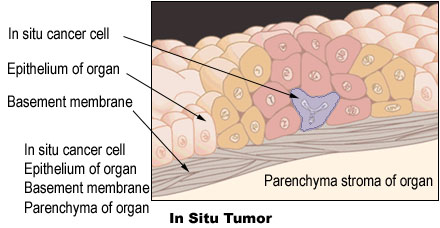In Situ (code = 0)
"In situ" is Latin, and literally translates to English as "in place." The technical definition of in situ is the presence of malignant cells within the cell group from which they arose. There is no penetration of the basement membrane of the tissue and no stromal invasion. Generally, a cancer begins in the rapidly dividing cells of the epithelium of an organ and grows from the inside to the outside of the organ. An in situ cancer fulfills all pathologic criteria for malignancy except that it has not invaded the supporting structure of the organ on which it arose.

An in situ diagnosis can only be made microscopically, because a pathologist must identify the basement membrane and determine that it has not been penetrated. If the basement membrane has been invaded (in other words, the pathologist describes the tumor as "microinvasive"), the case is no longer in situ and is at least localized. Pathologists have many ways of describing in situ cancer, such as non-invasive, pre-invasive, non-infiltrating, intra-epithelial, Stage 0, intraductal, intracystic, no stromal invasion, and no penetration below the basement membrane. Organs and tissues that have no epithelial layer cannot be staged as in situ, since they do not have a basement membrane. Therefore, there cannot be a diagnosis of sarcoma in situ, for example.



